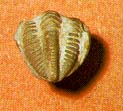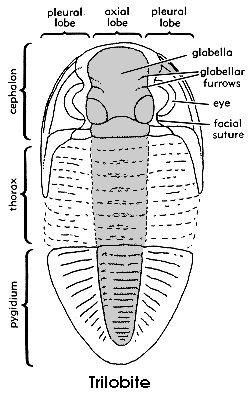



Ancient Life in Kansas Rocks, part 19 of 27

Ameura belongs to a long extinct of animals called trilobites. Classified with the arthopods (jointed legs) which includes spiders, lobsters, crabs, and insects, the Recent representative that most nearly resembles them is the horshoe crab. Trilobites lived exclusively in the sea and were very complex animals. They developed as organisoms without preservable hard parts many millions of years before the early Cambrian whre they first appear as fossils.

Trilobites recive their name from reference to the three longitudinal lobes (see drawing above) into which the body is divided. The axial or central lobe flanked on each side by pleural lobes. It was common for certain trilobites to fold or roll up upon death or when disturbed like the modern "pill bug." The photograph shows the pygidium, or last segment, and part of the thorax (middle segment) of an enrolled specimen. (Winterset Limestone, Upper Pennsylvanian)
Kansas Geological Survey
Placed online Feb. 1997
URL = "http://www.kgs.ku.edu/Publications/ancient/f19_trilobites.html"
Send comments and/or suggestions to webadmin@kgs.ku.edu